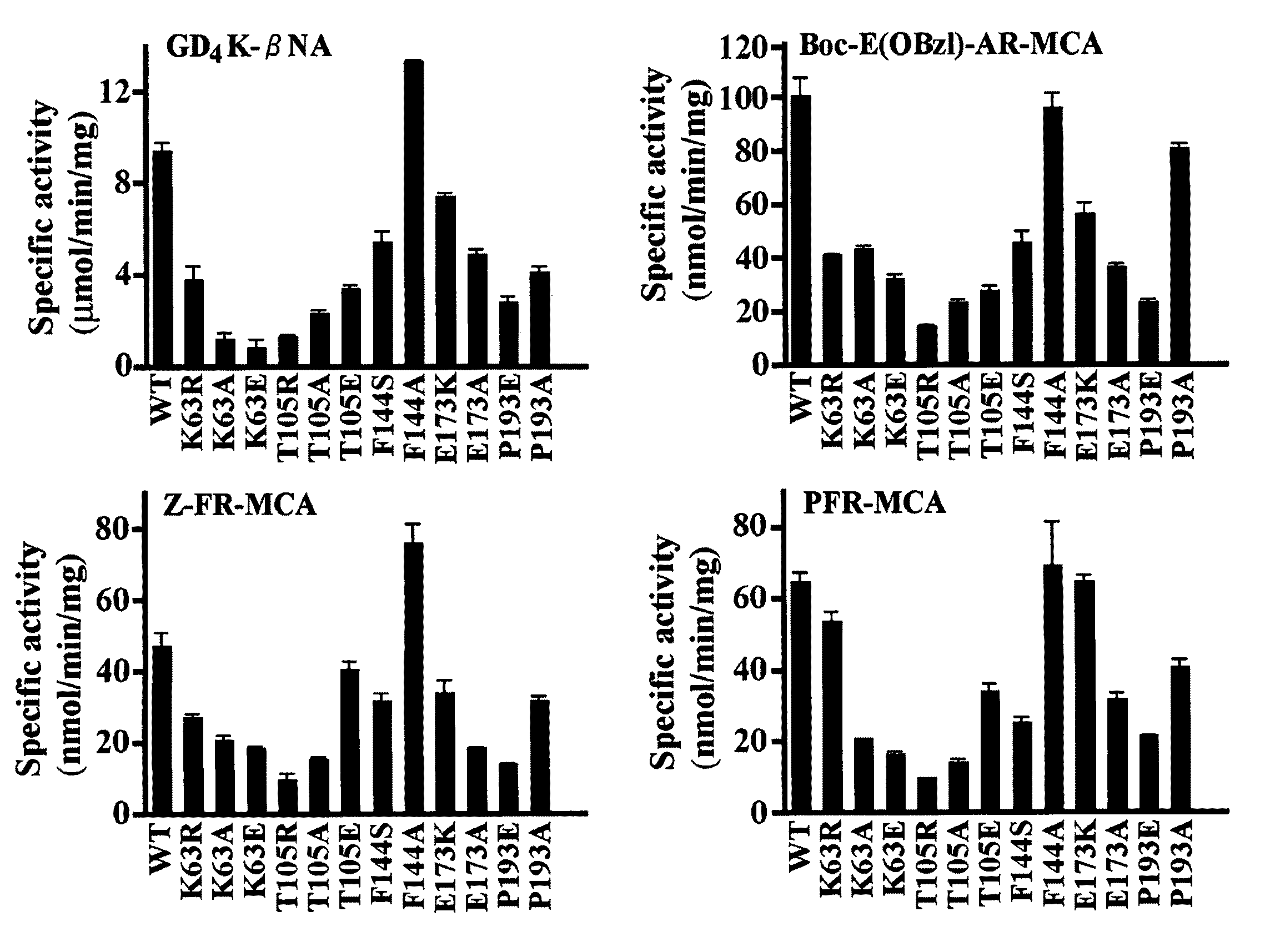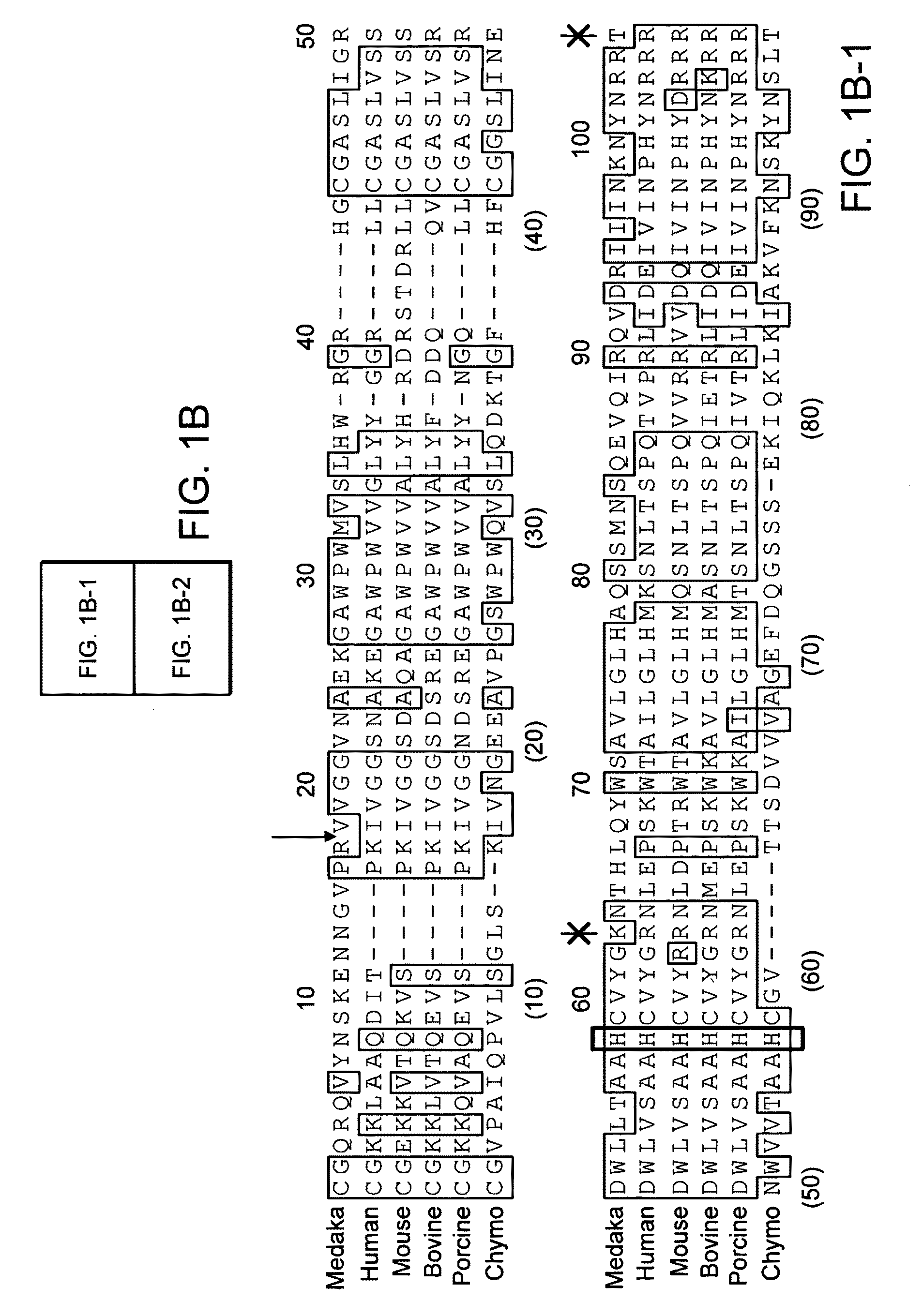Modified enteropeptidase protein
a technology of enteropeptidase and ep, which is applied in the field of new enteropeptidase (ep) variant polypeptides, can solve the problems of low yield of targeted protein, significant drawbacks of industrial application, and inability to make available information on ep in vertebrates other than mammals, etc., and achieves enhanced stability
- Summary
- Abstract
- Description
- Claims
- Application Information
AI Technical Summary
Benefits of technology
Problems solved by technology
Method used
Image
Examples
example 1
cDNA Cloning and Expression of Medaka EP
[0186]RNA was isolated from the intestine and ovary of Medaka using Isogen (Nippon Gene, Tokyo, Japan). From the thus-obtained total RNA of the Medaka intestine, the first strand of cDNA was synthesized using a SuperScript First-Strand Synthesis System for RT-PCR (Invitrogen, Carlsbad, Calif.). Two degenerate oligonucleotide PCR primers were synthesized based on the cDNA sequences for conserved C-terminal catalytic protease domains in mammalian EPs (sense primer: 5′-TCIGC(C / T)GC(A / C)CACTG(C / T)GT(C / G)TA(CM(A / G)G(A / G)-3′ (SEQ ID NO: 33), which corresponds to the sequence around the active site histidine, NH2-Ser-Ala-Ala-His-Cys-Val-Tyr-Gly-COOH (SEQ ID NO: 34); and antisense primer: 5′-(G / T)A(A / G)TGG(C / T)CC(G / T)CC(A / T)GAATC(A / C)CCCTG-3′ (SEQ ID NO: 35), which corresponds to the sequence around the active site serine, NH2— Gln-Gly-Asp-Ser-Gly-Gly-Pro-Leu-COOH (SEQ ID NO: 36)).
[0187]The thus-obtained cDNAs were amplified under the following PCR co...
example 2
Preparation and Properties of Recombinant EP Serine Protease Domain
[0198]A DNA fragment including the coding sequence for the Medaka EP-1 or EP-2 catalytic domain was amplified by PCR using a pBluescript II plasmid containing cDNA of the catalytic domain as the template. The upper and lower primers were 5′-CGCGGATCCCAAGCTGGTGTGGTGGGTGG-3′ (SEQ ID NO: 39) and 5′-CCCAAGCTTTCAGTCTAGATCTGAGAA-3′ (SEQ ID NO: 40), respectively, which had BamHI and HindIII sites at the respective 5′ termini. The product was ligated into the cloning site of a pET30a expression vector (Novagen, Madison, Wis.). Expression of the recombinant Medaka EP catalytic domain in the Escherichia coli expression system was carried out as described previously (Ogiwara et al., Proc. Natl. Acad. Sci. USA, 102:8442-8447 (2005)). The Medaka EP catalytic domain was produced as a fusion protein with an extra amino acid sequence of 50 residues at its N-terminus; the vector-derived N-terminal stretch contained a His-tag and an S...
example 3
Site-Directed Mutagenesis
[0208]Site-directed mutagenesis of Medaka EP-1 was carried out to produce various mutant proteases. For each mutant, two PCR products were first amplified with Medaka EP-1 cDNA as a template using the following primer combinations: one primer combination was the “upper” primer described above and the respective antisense primer, and another combination was the “lower” primer described above and the sense primer. These primers are shown in Table 3, below. Using a mixture of these amplified DNAs as templates, the second PCR was performed with the “upper” and “lower” primer. The PCR products were digested with BamHI and HindIII, gel-purified, and ligated into the pET30a expression vector. All mutants were confirmed by DNA sequencing. The subsequent procedures for preparation of mutant proteases were the same as for the wild-type protein described above. The active recombinant protein concentrations were determined using the active site titrant p-nitrophenyl-p′-...
PUM
| Property | Measurement | Unit |
|---|---|---|
| diameter | aaaaa | aaaaa |
| pH | aaaaa | aaaaa |
| pH | aaaaa | aaaaa |
Abstract
Description
Claims
Application Information
 Login to View More
Login to View More - R&D
- Intellectual Property
- Life Sciences
- Materials
- Tech Scout
- Unparalleled Data Quality
- Higher Quality Content
- 60% Fewer Hallucinations
Browse by: Latest US Patents, China's latest patents, Technical Efficacy Thesaurus, Application Domain, Technology Topic, Popular Technical Reports.
© 2025 PatSnap. All rights reserved.Legal|Privacy policy|Modern Slavery Act Transparency Statement|Sitemap|About US| Contact US: help@patsnap.com



